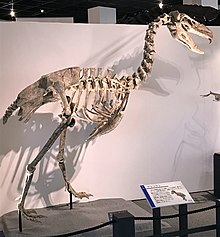Cariamiformes
| Cariamiformes Temporal range:
Suspected, but still not confirmed, late Cretaceous origin by molecular clock | |
|---|---|

| |
| Red-legged seriema, Cariama cristata (Cariamidae) | |

| |
| Kelenken (Phorusrhacidae) | |
| Scientific classification | |
| Domain: | Eukaryota |
| Kingdom: | Animalia |
| Phylum: | Chordata |
| Class: | Aves |
| Clade: | Australaves |
| Order: | Cariamiformes Fürbringer, 1888 |
| Families | |
Cariamiformes (or Cariamae) is an order of primarily flightless birds that has existed for over 50 million years. The group includes the family Cariamidae (seriemas) and the extinct families such as Phorusrhacidae, Bathornithidae, Idiornithidae and Ameghinornithidae. Extant members (seriemas) are only known from South America, but fossils of many extinct taxa are also found in other continents including Europe and North America. Though traditionally considered a suborder within Gruiformes, both morphological and genetic studies[3] show that it belongs to a separate group of birds, Australaves, whose other living members are Falconidae, Psittaciformes and Passeriformes.[4]
This proposal has been confirmed by a 2014 study of whole genomes of 48 representative bird species.[5] This analysis shows that the Cariamiformes are basal among extant Australaves, while falcons are next most basal; in combination with the fact that the two most basal branches of Afroaves (New World vultures plus Accipitriformes, and owls) are also predatory, it is inferred that the common ancestor of 'core landbirds' (Telluraves) was an apex predator.[5] However, some researchers like Darren Naish feel that this assessment is biased towards the more well known, predatory representatives of the clade,[6] and indeed at least one form, Strigogyps, appears to have been herbivorous.[7]
The earliest known unambiguous member of this group is early Eocene taxon Paleopsilopterus itaboraiensis.[2] An isolated femur from the Cape Lamb Member of the Lopez de Bertodano Formation, Vega Island, Antarctica was briefly described as a cariamiform femur in 2006. This specimen, which dates to the late Cretaceous period 66 million years ago, was originally reported as indistinguishable from the femurs of modern seriemas, and belonging to a large bird about 1 metre (3.3 ft) tall. Because of its age and geographic location, it was argued that this unnamed species may have been close to the ancestry of both cariamids and phorusrhacids.[8] However, a subsequent study published by West et al. (2019) reinterpreted this specimen as a fossil of an unnamed large-bodied member of a non-cariamiform genus Vegavis.[9] In 2024, two ungual phalanx specimens from the early Eocene strata in Antarctica have been identified as those of a cariamiform, possibly of a phorusrachid.[10]
Molecular phylogenetic studies have shown that Cariamiformes is basal to the Falconiformes, Psittaciformes and Passeriformes:[4]
| Australaves |
| |||||||||||||||||||||
References
- ^ Mayr, G. 2005. "Old World phorusrhacids" (Aves, Phorusrhacidae): a new look at Strigogyps ("Aenigmavis") sapea (Peters 1987). PaleoBios
- ^ a b c Mayr, G. (2022). "Accipitriformes (New World Vultures, Hawks, and Allies), Falconiformes (Falcons), and Cariamiformes (Seriemas and Allies)". Paleogene Fossil Birds. Fascinating Life Sciences (Second ed.). Springer Cham. pp. 153–176. doi:10.1007/978-3-030-87645-6_8. ISBN 978-3-030-87644-9. S2CID 246810485.
- ^ Hackett, Shannon J.; et al. (2008-06-27). "A Phylogenomic Study of Birds Reveals Their Evolutionary History". Science. 320 (5884): 1763–1768. Bibcode:2008Sci...320.1763H. doi:10.1126/science.1157704. PMID 18583609. S2CID 6472805. Retrieved 2008-10-18.
- ^ a b Prum, R.O.; Berv, J.S.; Dornburg, A.; Field, D.J.; Townsend, J.P.; Lemmon, E.M.; Lemmon, A.R. (2015). "A comprehensive phylogeny of birds (Aves) using targeted next-generation DNA sequencing". Nature. 526 (7574): 569–573. Bibcode:2015Natur.526..569P. doi:10.1038/nature15697. PMID 26444237.
- ^ a b Jarvis, E. D.; Mirarab, S.; Aberer, A. J.; Li, B.; Houde, P.; Li, C.; Ho, S. Y. W.; Faircloth, B. C.; Nabholz, B.; Howard, J. T.; Suh, A.; Weber, C. C.; Da Fonseca, R. R.; Li, J.; Zhang, F.; Li, H.; Zhou, L.; Narula, N.; Liu, L.; Ganapathy, G.; Boussau, B.; Bayzid, M. S.; Zavidovych, V.; Subramanian, S.; Gabaldon, T.; Capella-Gutierrez, S.; Huerta-Cepas, J.; Rekepalli, B.; Munch, K.; et al. (2014). "Whole-genome analyses resolve early branches in the tree of life of modern birds" (PDF). Science. 346 (6215): 1320–1331. Bibcode:2014Sci...346.1320J. doi:10.1126/science.1253451. hdl:10072/67425. PMC 4405904. PMID 25504713. Archived from the original (PDF) on 2015-02-24. Retrieved 2015-08-29.
- ^ Naish, Darren. "Bird behaviour, the 'deep time' perspective". scientificamerican.com. Retrieved 12 April 2018.
- ^ Gerald Mayr, Exceptionally preserved plant parenchyma in the digestive tract indicates a herbivorous diet in the Middle Eocene bird Strigogyps sapea (Ameghinornithidae)
- ^ Case, J.; Reguero, M.; Martin, J.; Cordes-Person, A. (2006). "A cursorial bird from the Maastrictian of Antarctica". Journal of Vertebrate Paleontology. 26 (3): 48A.
- ^ Abagael R. West; Christopher R. Torres; Judd A. Case; Julia A. Clarke; Patrick M. O'Connor; Matthew C. Lamanna (2019). "An avian femur from the Late Cretaceous of Vega Island, Antarctic Peninsula: removing the record of cursorial landbirds from the Mesozoic of Antarctica". PeerJ. 7: e7231. doi:10.7717/peerj.7231. PMC 6626523. PMID 31333904.
- ^ Acosta Hospitaleche, Carolina; Jones, Washington (2024). "Were terror birds the apex continental predators of Antarctica? New findings in the early Eocene of Seymour Island". Palaeontologia Electronica. 27 (1): 1–31. doi:10.26879/1340.
Further reading
- Mayr, Gerald (2009). "Cariamae (seriemas and allies)". Paleogene Fossil Birds. Berlin, Heidelberg: Springer Berlin Heidelberg. pp. 139–152. doi:10.1007/978-3-540-89628-9_13. ISBN 978-3-540-89627-2.



